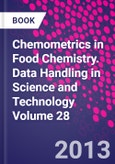The issues related to food science and authentication are of particular importance for researchers, consumers and regulatory entities. The need to guarantee quality foodstuff - where the word "quality" encompasses many different meanings, including e.g. nutritional value, safety of use, absence of alteration and adulterations, genuineness, typicalness, etc. - has led researchers to look for increasingly effective tools to investigate and deal with food chemistry problems. As even the simplest food is a complex matrix, the way to investigate its chemistry cannot be other than multivariate. Therefore, chemometrics is a necessary and powerful tool for the field of food analysis and control.
For food science in general and food analysis and control in particular, there are several problems for which chemometrics are of utmost importance. Traceability, i.e. the possibility of verifying the animal/botanical, geographical and/or productive origin of a foodstuff, is, for instance, one area where the use of chemometric techniques is not only recommended but essential: indeed, at present no specific chemical and/or physico-chemical markers have been identified that can be univocally linked to the origin of a foodstuff and the only way of obtaining reliable traceability is by means of multivariate classification applied to experimental fingerprinting results.
Another area where chemometrics is of particular importance is in building the bridge between consumer preferences, sensory attributes and molecular profiling of food: by identifying latent structures among the data tables, bilinear modeling techniques (such as PCA, MCR, PLS and its various evolutions) can provide an interpretable and reliable connection among these domains. Other problems include process control and monitoring, the possibility of using RGB or hyperspectral imaging techniques to nondestructively check food quality, calibration of multidimensional or hyphenated instruments etc.
Please Note: This is an On Demand product, delivery may take up to 11 working days after payment has been received.
Table of Contents
1. Introduction, Federico Marini Theory 2. Experimental Design, Riccardo Leardi 3. Exploratory Data Analysis, Mario Li Vigni, Caterina Durante, and Marina Cocchi 4. Regression, Frank Westad, Marta Bevilacqua, and Federico Marini 5. Classification and Class-Modelling, M. Bevilacqua, R. Bucci, A.D. Magrì, A.L. Magrì, R. Nescatelli, and F. Marini 6. Multivariate Curve Resolution Methods for Food Chemistry, Anna de Juan and Sílvia Mas 7. Multi Way Methods, José Manuel Amigo and Federico Marini 8. Robust Methods in Analysis of Multivariate Food Chemistry Data, Stanimirova, M. Daszykowski, and B. Walczak Applications 9. Hyperspectral Imaging and Chemometrics: A Perfect Combination for the Analysis of Food Structure, Composition and Quality, José Manuel Amigo, Idoia Martí, and Aoife Gowen 10. The Impact of Chemometrics on Food Traceability, Lucia Bertacchini, Marina Cocchi, Mario Li Vigni, Andrea Marchetti, Elisa Salvatore, Simona Sighinolfi, Michele Silvestri, and Caterina Durante 11. NMR-Based Metabolomics in Food Quality Control, A. Tomassini, G. Capuani, M. Delfini, and A. Miccheli 12. Interval Based Chemometric Methods in NMR-Foodomics, Francesco Savorani, Morten Arendt Rasmussen, Åsmund Rinnan, and Søren Balling Engelsen








